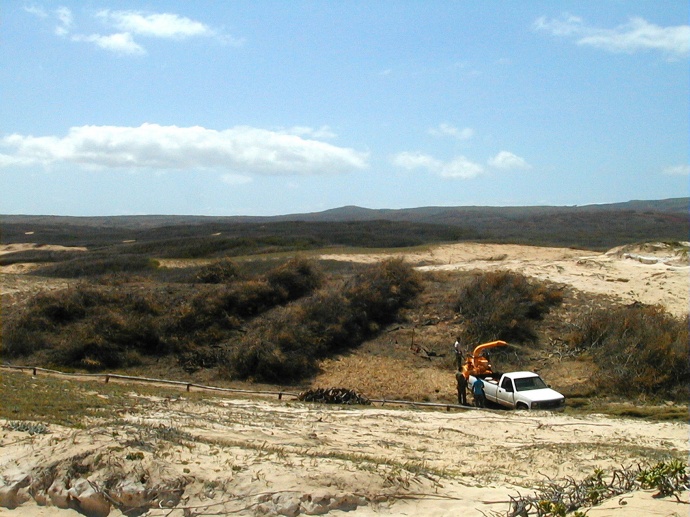Removal of Kiawe Sparks Native Recovery at Mo’omomi
By Wendy Osher
The Nature Conservancy is reporting positive recovery efforts are underway at the Moʻomomi Reserve on Molokaʻi.
The conservation organization has been working with the Molokaʻi Land Trust to restore the area by removing alien kiawe thickets and allowing the area to regenerate with native growth.
Nature Conservancy officials say the fragile sand dunes of Moʻomomi are now blooming with new native growth including the blue blossoms of paʻu o Hiʻiaka and, the yellow flowers of ʻilima, the spiky native ʻaki ʻaki, and shimmering hinahina.
Authorities say the dunes were once overrun with single-species thickets of introduced kiawe, which was brought to Hawai`i to support cattle ranching.
“Kiawe transforms the ecosystem. It forms dense thickets. If there’s a fire, it burns hot and hard. Since it’s a legume and fixes nitrogen, it changes the soil,” said Russell Kallstrom, graphical information system coordinator for the Conservancy’s Molokaʻi Program in a media release.
Crews conducted kiawe removal and implemented predator and weed control as part of the program.
The Nature Conservancy began kiawe control at its 921-acre Moʻomomi Preserve in 1998, under the direction of its Molokaʻi Program manager, Ed Misaki.
“The idea of passive restoration was to focus on removing invasive species and let the natives naturally regenerate—removing the threats and allowing the native system to heal itself, basically,” Misaki said.
Nature Conservancy officials say the the restoration efforts have not only proven beneficial for native plants, but also have helped by improving habitat for the uaʻu kani or wedge-tailed shearwater.
The number of wedge-tailed shearwater burrows have reportedly increased from three nests in 1999 to 704 nests in 2012.
“It seems like the shearwaters were trying to recolonize before 1999, but feral cats used the safety of kiawe thickets as staging areas for raids on the nests,” said Wailana Moses, the Conservancy’s Moloka’i weed coordinator.
“When we removed some of the kiawe clumps near the bird colony, we would find piles of shearwater wings.”
Threats posed for the shearwaters include: mongooses that prey primarily on eggs, cats that take birds one at a time, and dogs that occasionally wipe out dozens at a time. In 2009, authorities note that a single dog killed 60 shearwaters in one night.
Since its inception, the kiawe removal program has cleared a little over nine acres in the program’s 14 years of operation.













